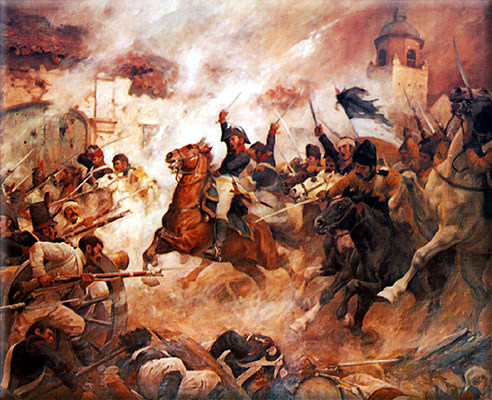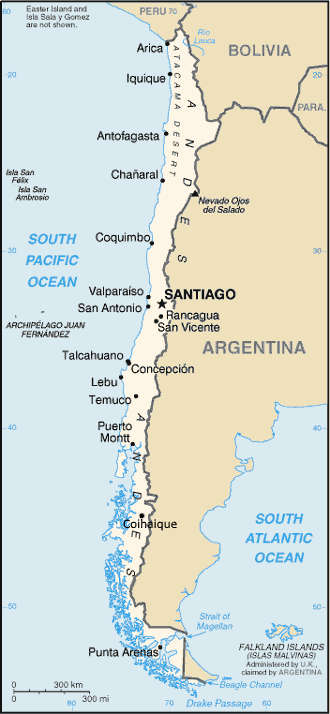|
Rancagua, Chile
Rancagua () is a city and commune in central Chile and part of the Rancagua conurbation. It is the capital of the Cachapoal Province and of the O'Higgins Region, located south of the national capital of Santiago. It was originally named Santa Cruz de Triana by Spanish colonists. In 2012, its population was 232,211. The main economic activities range from mining, tourism, agriculture, timber, food production and services to minor industrial activities. The city also serves as the administrative and legal center of the region. Together with Machalí and Gultro, it forms the Rancagua conurbation. After Curicó, Talca and Concepción, it is one of the most important and densely populated cities of the south central zone of Chile. History Foundation period The Rancagua Valley was occupied by the local Picunche. They fell briefly under the control of the Inca Empire in the 15th century. Its remains in structures can still be found near the city today. Through their civil engineeri ... [...More Info...] [...Related Items...] OR: [Wikipedia] [Google] [Baidu] |
List Of Cities In Chile
This is a list of cities in Chile. A city is defined by Chile's National Statistics Institute (INE) as an "urban entity"An "urban entity" is defined by Chile's National Statistics Institute as a concentrated group of dwellings with over 2,000 inhabitants, or between 1,001 and 2,000 inhabitants if 50% or more of its population is economically active, dedicated to secondary and/or tertiary activities. Exceptionally, populated centers dedicated to tourism and recreation with over 250 concentrated dwellings and that do not meet the population requirement are considered urban. with more than 5,000 inhabitants. This list is based on a June 2005 report by the INE based on the 2002 census which registered 239 cities across the country. Complete list of cities by region Largest urban agglomerations This list includes conurbations, "absorptions" and cities with over 100,000 inhabitants, according to the 2017 census. {, {, class="wikitable sortable" , - !, !!Urban Entity!!Region!!Po ... [...More Info...] [...Related Items...] OR: [Wikipedia] [Google] [Baidu] |
Rancagua Conurbation
Rancagua conurbation, or Greater Rancagua, is a Chilean conurbation in the O'Higgins Region composed of Rancagua and some parts of Machalí and Gultro. It has an estimated population of 307,004 inhabitants for 2008. Several villages are expected to join the conurbation in a near future, like Olivar Bajo ( Olivar), Punta de Cortés (Rancagua) and La Compañia (Graneros). Rancagua Rancagua () is a city and commune in central Chile and part of the Rancagua conurbation. It is the capital of the Cachapoal Province and of the O'Higgins Region, located south of the national capital of Santiago. It was originally named Sant ... Populated places in Cachapoal Province {{O'Higgins-geo-stub ... [...More Info...] [...Related Items...] OR: [Wikipedia] [Google] [Baidu] |
Picunche
The Picunche (a Mapudungun word meaning "North People"), also referred to as ''picones'' by the Spanish, were a Mapudungun-speaking people living to the north of the Mapuches or Araucanians (a name given to those Mapuche living between the Itata and Toltén rivers) and south of the Choapa River and the Diaguitas. Until the Conquest of Chile the Itata was the natural limit between the Mapuche, located to the south, and Picunche, to the north. During the Inca attempt to conquer Chile the southern Picunche peoples that successfully resisted them were later known as the Promaucaes. The Picunche living north of the Promaucaes were called ''Quillotanes'' (those living in the Aconcagua River valley north to the Choapa) and ''Mapochoes'' (those living in the Maipo River basin) by the Spanish, and were part of the Inca Empire at the time when the first Spaniards arrived in Chile. Among the peoples the Spanish called the Promaucaes, the people of the Rapel River valley were particularly ... [...More Info...] [...Related Items...] OR: [Wikipedia] [Google] [Baidu] |
Greater Concepción
Gran Concepción is the third largest conurbation in Chile, after Greater Santiago and Greater Valparaíso, with 945,650 inhabitants according to the 2012 pre census. Overview It takes its name after the city of Concepción, the regional capital and main city. The agglomeration is composed of: * Concepción * Talcahuano * Chiguayante * San Pedro de la Paz * Hualpén * Penco * Tomé * Coronel * Lota * Hualqui Gran Concepción has also the second largest concentration of universities in Chile. Apart from the so-called Traditional Universities, it has several private institutions. The Universidad de Concepción is the most important university in the conurbation. There is also a commuter rail system which serves most of the communes ( es, comunas) in the conurbation: Biotren. Commerce The commerce in Greater Concepcion is mostly located in Concepcion city center, also in the Mall Plaza el Trebol, in Talcahuano. Education Universities * Universidad de Concepción ... [...More Info...] [...Related Items...] OR: [Wikipedia] [Google] [Baidu] |
Talca
Talca () is a List of cities in Chile, city and Communes of Chile, commune in Chile located about south of Santiago, Chile, Santiago, and is the capital of both Talca Province and Maule Region (7th Region of Chile). As of the 2012 census, the city had a population of 201,142. The city is an important economic center, with agricultural (wheat) and manufacturing activities, as well as wine production. It is also the location of the Universidad de Talca and the Catholic University of Maule, among others. The Catholic Church of Talca has held a prominent role in the history of Chile. The inhabitants of Talca have a saying, ''Talca, Paris & London'', born from a hat shop which had placed a ribbon stating that it had branches in Paris and London. The shop was owned by a French immigrant named Jean-Pierre Lagarde. Demographics According to the 2002 census of the National Statistics Institute (Chile), National Statistics Institute, Talca spans an area of and had, in that year, 201,7 ... [...More Info...] [...Related Items...] OR: [Wikipedia] [Google] [Baidu] |
Curicó
Curicó (), meaning "Black Waters" in Mapudungun (originally meaning "Land of Black Water"), is the capital city of the Curicó Province, part of the Maule Region in Chile's central valley. The province lies between the provinces of Colchagua and Talca and extends from the Pacific to the Argentine frontier. Demographics According to the 2012 census of the National Statistics Institute, Curicó spans an area of and has 147,017 inhabitants (68,768 men and 70,817 women). Of these, 130,506 (84%) lived in urban areas and 19,079 (16%) in rural areas. Between the 1992 and 2002 censuses, the population grew by 14.9% (15,472 persons). Geography Curicó is on the Guaiquillo River, south of Santiago along the route of the Chilean Central Railway. The city is situated in the fertile Chilean Central Valley, above sea-level, in the midst of a comparatively well-cultivated region. The eastern and western sides are mountainous, separated by the Chilean Central Valley. A volcano call ... [...More Info...] [...Related Items...] OR: [Wikipedia] [Google] [Baidu] |
Machalí
Machalí is a Chilean commune and city in Cachapoal Province, O'Higgins Region. Demographics According to the 2002 census of the National Statistics Institute, Machalí spans an area of and has 28,628 inhabitants (14,297 men and 14,331 women). Of these, 26,852 (93.8%) lived in urban areas and 1,776 (6.2%) in rural areas. The population grew by 18.5% (4,476 persons) between the 1992 and 2002 censuses. Administration As a commune, Machalí is a third-level administrative division of Chile administered by a municipal council, headed by an alcalde who is directly elected every four years. The 2008-2012 alcalde is José Miguel Urrutia. Within the electoral divisions of Chile, Machalí is represented in the Chamber of Deputies by Eugenio Bauer (UDI) and Ricardo Rincón ( PDC) as part of the 33rd electoral district, together with Mostazal, Graneros, Codegua, Requínoa, Rengo, Olivar, Doñihue, Coinco, Coltauco, Quinta de Tilcoco and Malloa. The commune is represented in the Senat ... [...More Info...] [...Related Items...] OR: [Wikipedia] [Google] [Baidu] |
Food Production
The food industry is a complex, global network of diverse businesses that supplies most of the food consumed by the world's population. The food industry today has become highly diversified, with manufacturing ranging from small, traditional, family-run activities that are highly labor-intensive, to large, capital-intensive and highly mechanized industrial processes. Many food industries depend almost entirely on local agriculture, produce, or fishing. It is challenging to find an inclusive way to cover all aspects of food production and sale. The UK Food Standards Agency describes it as "the whole food industry – from farming and food production, packaging and distribution, to retail and catering." The Economic Research Service of the USDA uses the term ''food system'' to describe the same thing, stating: "The U.S. food system is a complex network of farmers and the industries that link to them. Those links include makers of farm equipment and chemicals as well as firms th ... [...More Info...] [...Related Items...] OR: [Wikipedia] [Google] [Baidu] |
Timber
Lumber is wood that has been processed into dimensional lumber, including beams and planks or boards, a stage in the process of wood production. Lumber is mainly used for construction framing, as well as finishing (floors, wall panels, window frames). Lumber has many uses beyond home building. Lumber is sometimes referred to as timber as an archaic term and still in England, while in most parts of the world (especially the United States and Canada) the term timber refers specifically to unprocessed wood fiber, such as cut logs or standing trees that have yet to be cut. Lumber may be supplied either rough- sawn, or surfaced on one or more of its faces. Beside pulpwood, ''rough lumber'' is the raw material for furniture-making, and manufacture of other items requiring cutting and shaping. It is available in many species, including hardwoods and softwoods, such as white pine and red pine, because of their low cost. ''Finished lumber'' is supplied in standard sizes, mostly ... [...More Info...] [...Related Items...] OR: [Wikipedia] [Google] [Baidu] |
Agriculture
Agriculture or farming is the practice of cultivating plants and livestock. Agriculture was the key development in the rise of sedentary human civilization, whereby farming of domesticated species created food surpluses that enabled people to live in cities. The history of agriculture began thousands of years ago. After gathering wild grains beginning at least 105,000 years ago, nascent farmers began to plant them around 11,500 years ago. Sheep, goats, pigs and cattle were domesticated over 10,000 years ago. Plants were independently cultivated in at least 11 regions of the world. Industrial agriculture based on large-scale monoculture in the twentieth century came to dominate agricultural output, though about 2 billion people still depended on subsistence agriculture. The major agricultural products can be broadly grouped into foods, fibers, fuels, and raw materials (such as rubber). Food classes include cereals (grains), vegetables, fruits, cooking oils, meat, milk, ... [...More Info...] [...Related Items...] OR: [Wikipedia] [Google] [Baidu] |
Tourism
Tourism is travel for pleasure or business; also the theory and practice of touring (other), touring, the business of attracting, accommodating, and entertaining tourists, and the business of operating tour (other), tours. The World Tourism Organization defines tourism more generally, in terms which go "beyond the common perception of tourism as being limited to holiday activity only", as people "travelling to and staying in places outside their usual environment for not more than one consecutive year for leisure and not less than 24 hours, business and other purposes". Tourism can be Domestic tourism, domestic (within the traveller's own country) or International tourism, international, and international tourism has both incoming and outgoing implications on a country's balance of payments. Tourism numbers declined as a result of a strong economic slowdown (the late-2000s recession) between the second half of 2008 and the end of 2009, and in consequence of t ... [...More Info...] [...Related Items...] OR: [Wikipedia] [Google] [Baidu] |





